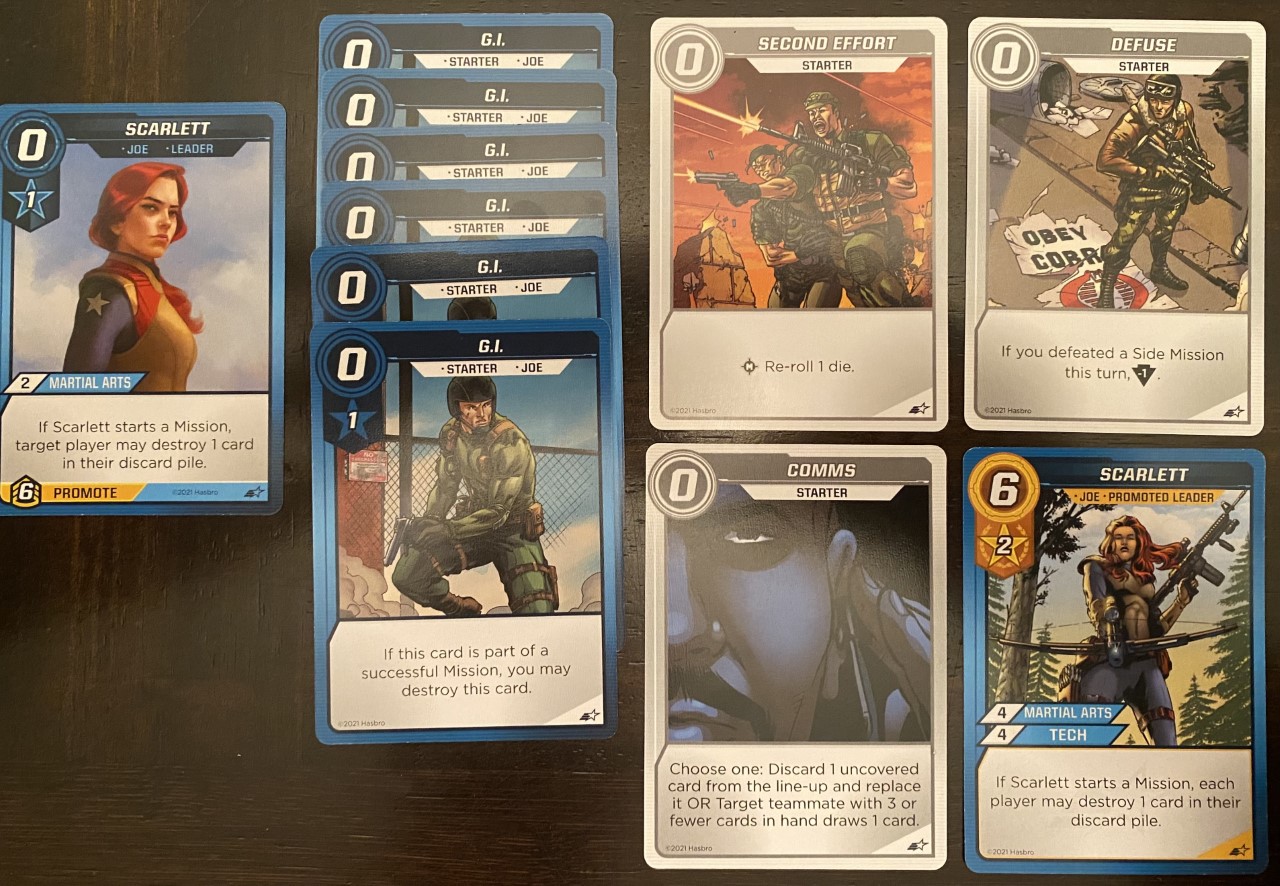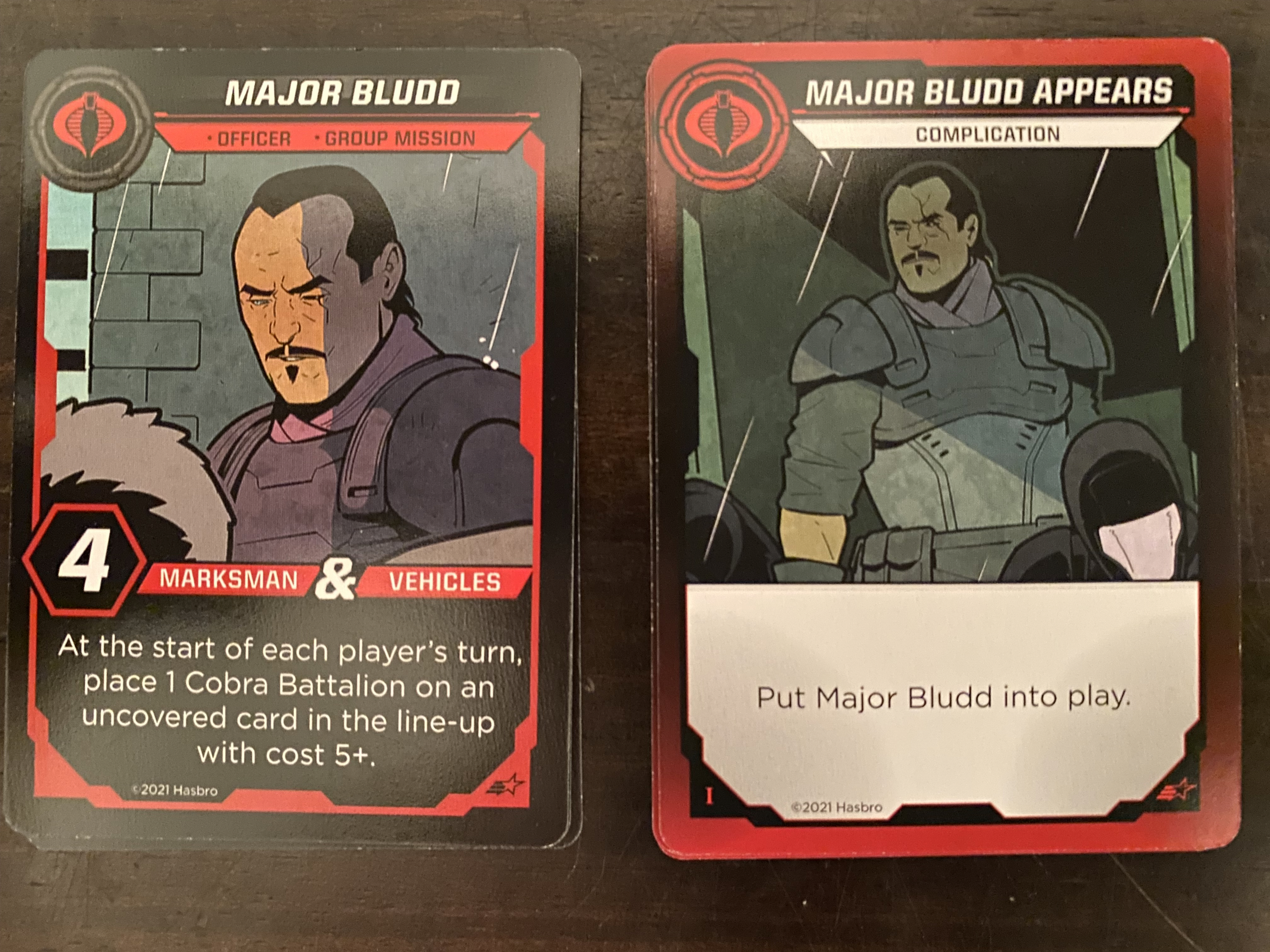To give you some idea of where I stand with GI Joe Deck-Building Game. I’ll start by letting you know that as soon as I saw the pre-order option this was in my cart along with the G.I. Joe RPG Core Rulebook (expected Q2-2022). Then when I saw the game had shipped from Renegade Games I went on YouTube and started watching the cartoon (these Episodes were released free from Hasbro). The first five episodes are called “The M.A.S.S. Device” and one of the included missions in this deck-builder is based on those episodes. The second mission is an original designed for this game, but I still think it’s a good idea to watch at least these first 5 as it really helped refresh my nostalgia.
Overall, I love this game and that’s why it saddens me that the first thing I want to talk about, learning the rules, is the weakest thing in the whole package. I read the rulebook as a pdf before I got the game and without seeing the actual cards and game components this was a bit difficult. Once I got the game I went through the rulebook and set the game up using the rulebook’s directions and had several questions that made learning frustrating and going through the rulebook again didn’t help. I left my game set up and waited for the How to Play videos to come out. When I finally checked a couple weeks later, I watched multiple How to Play videos and they were excellent. The game itself isn’t that difficult to play or learn but this learning process could have been a lot better. After watching these videos, I joined the Discord, searched the questions on boardgamegeek.com and then I went back and read the rulebook and it didn’t seem that bad. My biggest complaint is that it doesn’t give enough examples and explain the timing for card interactions well. The great news for you is the process I’ve done is way harder than it would be for you, just watch a How to Play video (and the first five episodes if you have time) on YouTube and you don’t even need to look at the rulebook, so this problem goes away.
I’m going to go over the basics just so you can get an idea if this game is right for you. Set up the game per the instructions and make your initial decks for the number of players. I’m playing a two-player game so I’ve set up Snake Eyes and Scarlett. Both decks have 9 GI’s (your basic Joe), 3 Starter Cards (Defuse, Comms, Second Effort) and then you add your Leader Joe (Snake Eyes and Scarlett but there are 4 others that come in the box) with a 0 Recruit Cost (the number in the top left). These 10 cards will be shuffled together and then your Promoted Joe Leader (a gold 6 Recruit Cost in the top left) will be set to the side. Later, during a Recruit Phase when you have 6 Recruit Points (shown in the Star below the Recruit Cost) AND your starting leader you can promote them to swap out the promoted card in your deck and return the original to the box.
This game is broken down into Turns and Rounds, once every player (in this case Snake Eyes and Scarlett) have each had a turn then you will do the End of Round Actions.
This is all the sides of the Dice, The End of Round player aid (Circular Token you put between the 1st and last player), the Turn Sequence and Missions player aids.
These Player Aids were helpful and made it where the rulebook didn’t have to sit out to look up a lot of things while playing. Four of the Turn Sequence/Missions 2-sided cards comes with the game, one for each player.
The first Round everyone has a turn where they do nothing but Recruit (buy) cards from either the 6 random cards line up from the Main Deck or the Basic Service Rifle. As soon as a card is purchased from the line up a new card is drawn to replace it and you can spend your Recruit until you’re out or you don’t wish to buy anything else.
After everyone’s turns, Step 2 of the End of Round Actions is to increase the Threat. From here on you’re playing the game and the game only gets better from here. There are really only 4 phases every turn; the Start Phase where you refill the Story Mission if there isn’t one out. The Mission Phase where you go on as many Missions as you’d like and have enough Joes for. The Recruit Phase where you use the Joes, Gear, Utility Cards (including all the cards that were used on missions) to add cards to your deck and then the End Phase where the Story, Cobra Officers, Complications/Side Missions that have end of turn effects occur and then you’ll discard your hand and draw 5 cards. Then if it’s an end of a Round you’ll check those same cards again for end of round effects and then the Threat will go up by one.
This game has some great and unique mechanics. The missions themselves aren’t necessarily unique but the way they are handled, and variety are. Story Missions are just that, a mission from the story. Side Missions are either tied to a player such as a Precision Strike or limited to only the active player attempting with no assistance such as the Cobra Battalions that cover the lineup and reduce the number of cards available to recruit. The Story Missions are done randomly for each Act but the Active Story Mission AND the next Story Mission are face up so you can see what skills are required so you can plan and strategize. Most Story Missions will have random face down Complications attached to them (revealed when you attempt the Story Mission). When you fail or succeed at a Story Mission it will go into a special pile that affects later missions. That brings me to another great and unique mechanic, when you Recruit a card it goes to the TOP of your deck, meaning at the end of the turn when you discard and draw your 5 cards it will be one of them. (unless you purchased more than 5). The way the transports (the Vamp doesn’t give a bonus and is always available) can provide bonuses depending on the type of mission is cool too.
The Vamp
Cobra Troopers (clog up your deck but you can attack them as Side Missions to remove them) and Cobra Battalions (cover up the lineup and if they cover all 6 cards in the lineup you lose
Example Complications, these start off face-down and attached to the Story Mission (the Rattler Attack is a Precision Strike meaning it is given to a player as a side mission and they must beat it on their own to get rid of it)
So, you’re probably curious as to how many players should play this game. It plays 1-4 and I’ve played multiple Solo game and a 2-player game (Solo) and there is open communication allowed at the table, so I think any of the player counts work well for this game. I slightly prefer a 2-player game and playing 2 decks if I’m playing solo, but it works well either way.
How repayable is it? There are 2 Missions with 3 Act Finales (that are set) and each game you randomly choose 2 of 5 Missions per Act (so there are 5 possible Mission I, Act I Missions, 5 different Mission I, Act II Missions and 5 different Mission I, Act III Missions). Whenever a Story Mission comes out a certain number of Complications will normally come out as well. Without the order of the random act missions and not including the complications at all there is 16000 combinations. Now if you consider the Player Cards that come out 6 at a time for you to Recruit it becomes even more repayable. I’d also like to mention that those story missions and complications can bring out the Cobra Officers or other Side Missions. Renegade also has plans for some actual expansions (Bonus Box #1 was released with the pre-orders but doesn’t add Cobra cards) to add at more missions and probably more complication cards and player cards (such as the one in Bonus Box #1). I’ve played about 10 times and am still getting Story Missions, Complications, and Player Cards I haven’t seen yet.
Some people have had issues with the fact that dice are involved in Mission resolution and to be honest I think it fits thematically. After watching several of the cartoons you’ll see that the Joes don’t always win! Some deck-builders can feel like you’re performing a math problem cause you’re just trying to add up your cards to a certain number, but the dice prevent this from feeling like that. With no penalty for failing most side missions it means you’re free to take a shot and hope you roll the double success as well.
To show how the dice work in the game let us look at the Rattler Attack- Precision Strike Side Mission above (meaning it must be attached to a player when it is revealed and that other players can’t help you). Say this got attached to me last turn and I want to try to beat it this turn, and my hand consists of 4 G.I.’s and 1x Second Effort. It’s early game so the only Vehicle I have is the Vamp shown above (it fits 4 GI’s). I choose the Vamp and up to 4 Joes (only GIs are in my hand) to go on the mission, each GI provides 1 Die. There is no penalty for failing this mission so I would just commit 2 GIs in the Vamp and then roll 2 of the 6-sided dice (see the picture above, 3 sides Misses, 2 sides 1 Success, 1 side 2 Successes). If I got 1 success, I might use my Second Effort to reroll the other dice to try to get the required 2 success to beat this mission but if I didn’t get any successes, I may just set them aside and go on the same mission with my other 2 GI’s and have my Second Effort as a backup again. If I don’t manage to beat this mission, then at the end of my turn the Threat will go up by 1 but there is no penalty for each failure so technically I could just go on the mission 4 times and hope for the side of the dice that has 2 successes. There are several cards (including this Second Effort card that starts in every deck) that help to mitigate dice rolls. You can fail every single mission, including story missions, and if you beat the last mission of Act III, you will still win. There is a bonus for beating story missions and there’s also a penalty for failing them but to me the dice aren’t the problem. Story missions shouldn’t be attempted straight away, and if you build your deck up often early game and it will pay off later.
The last thing I’d like to say about this game is the strong thematic elements. This game nails the theme by combining the art style with certain mechanics that make you feel like you’re helping the Joes save the world and defeating Cobra. Using the transports each mission also pulls you into the world and the number one thing that makes this feel like GI Joe, it’s a cooperative game where you’re working together solo or with your friends, just like the Joes would do.
I’ve had fun with this game since I’ve learned to play it and I’ve been playing it now for several weeks with its quick set up and game time of about 60-90 minutes. It is for me been well worth the $39.99 retail.
My overall rating is 4.5 Yo Joe!’s out of 5 (the .5 off for the bad rulebook)


















